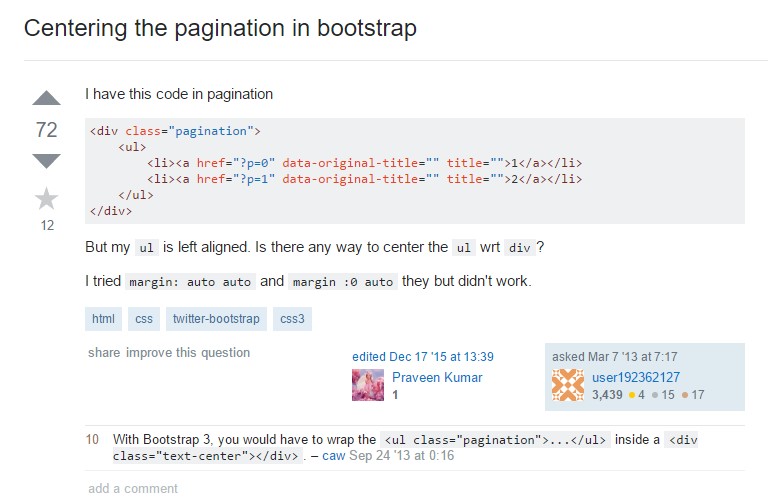Bootstrap Pagination Tutorial
Intro
An upward direction in the front-end community is the usage of the CSS frameworks alongside basic looks with regards to our web page. Rather than beginning each and every project from scratch, making each and every style in the hand , there are frameworks that currently bring a completely designed base from where we are going to create our app. There are different options, but Bootstrap is possibly the most recognized. It was delivered as open source and the project has produced in maturity and usefulness on the market.
Bootstrap carries a variety of capabilities:
● Totally reset CSS
● Basis graphic appearance for the majority of the tags
● Icons.
● Grids ready for use.
● CSS Components.
● JavaScript Plugins.
● All responsive and mobile-first .
As its name claims, it is a method to start the project shortly with a practical design and components without exhausting design time in the starting point.
Standard pagination methods.
Any time we have a page along with a lot of items to demonstrate, paging becomes important. We know that in the case of checklists, including displaying goods in internet shops or maybe search results in systems, the wish is not to show each of the products instantly, but in preference to organize them properly, preparing them much simpler to access, a lot faster and more standard webpages.
Listed below are some good practices in the use of Bootstrap Pagination, no matter the technology used ( read this)
Pagination: an additional title.
Paging dispenses the title when well designed. That is , if you will need to write "Pagination" for the user of Bootstrap Pagination Example to make use of, there is one thing inappropriate: consider redesigning it!
Excellent visibility and positioning.
Paging is a completing site navigation and should offer excellent positioning and excellent exposure. Work with fonts with sizes and colors that follow the pattern of page usage, providing really good exposure and placing it directly after the item list ends.
Be practical.
Many paging tools provide complicated navigating functions such as going directly to a certain page or advancing a certain quantity of webpages simultaneously. Even though they are extra functions, users are much more familiar with easy designs and produce better by using traditional designs.
Deliver ordering methods.
A good and advised feature is to bring sorting possibilities to optimize their usage.
Do not work with subscript styles on hyperlinks.
In paging tools, such functions are unnecessary, due to the fact that the hyperlinks are noticeable and the subscript style will simply just keep the visual loaded. ( recommended reading)
Give proper space for clickable parts.
The bigger the clickable space the better accessible the buttons get and for that reason much easier to put into action.
Deliver areas between web links
Field starting with one tab to some other will craft paging more user-friendly and comfortable , staying away from unwanted connection.
Identify the present web page and generate the basic navigating urls.
The paging work is to assist in user site navigation, so the device needs to keeping it very clear where exactly the user is, where he has been and where he is able to proceed.
Deliver primary navigation links like "Previous Page" together with "Next Page", regularly fixing them at the beginning and end.
Provide useful shortcuts and supplemental relevant information
Links to the "first page" and "last page" are usually helpful, keep in mind them assuming that it is necessary!
Take advantage of a wrapping
<nav>Also, as webpages likely have more than just one such navigation area, it's a good idea to deliver a descriptive
aria-labelaria-label="Search results pages".<nav aria-label="Page navigation example">
<ul class="pagination">
<li class="page-item"><a class="page-link" href="#">Previous</a></li>
<li class="page-item"><a class="page-link" href="#">1</a></li>
<li class="page-item"><a class="page-link" href="#">2</a></li>
<li class="page-item"><a class="page-link" href="#">3</a></li>
<li class="page-item"><a class="page-link" href="#">Next</a></li>
</ul>
</nav>Bootstrap Pagination
Standard Bootstrap Pagination Demo
You may want to add some kind of pagination to each page if you have a site with many pages.
To create a general pagination, incorporate the
.pagination<ul>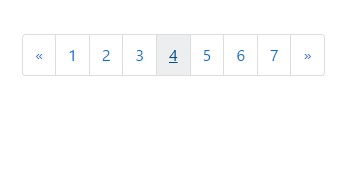
<nav>
<ul class="pagination">
<li class="page-item">
<a href="#" class="page-link" aria-label="Previous">
<span aria-hidden="true">«</span>
</a>
</li>
<li class="page-item"><a href="#" class="page-link">1</a></li>
<li class="page-item"><a href="#" class="page-link">2</a></li>
<li class="page-item"><a href="#" class="page-link">3</a></li>
<li class="page-item"><a href="#" class="page-link">4</a></li>
<li class="page-item"><a href="#" class="page-link">5</a></li>
<li class="page-item"><a href="#" class="page-link">6</a></li>
<li class="page-item"><a href="#" class="page-link">7</a></li>
<li class="page-item">
<a href="#" class="page-link" aria-label="Next">
<span aria-hidden="true">»</span>
</a>
</li>
</ul>
</nav>Bootstrap 4 and Bootstrap 3 changes
Bootstrap 3 only requests the
.paginationBootstrap 4, besides the
.pagination.page-item<li>.page-link<a>Working with icons
Wanting to make use of an icon or symbol in place of words for certain pagination web links? Ensure to provide appropriate screen reader assistance with
aria.sr-only<nav aria-label="Page navigation example">
<ul class="pagination">
<li class="page-item">
<a class="page-link" href="#" aria-label="Previous">
<span aria-hidden="true">«</span>
<span class="sr-only">Previous</span>
</a>
</li>
<li class="page-item"><a class="page-link" href="#">1</a></li>
<li class="page-item"><a class="page-link" href="#">2</a></li>
<li class="page-item"><a class="page-link" href="#">3</a></li>
<li class="page-item">
<a class="page-link" href="#" aria-label="Next">
<span aria-hidden="true">»</span>
<span class="sr-only">Next</span>
</a>
</li>
</ul>
</nav>Active capacity
The active state indicates precisely what the present page is.
Add
.active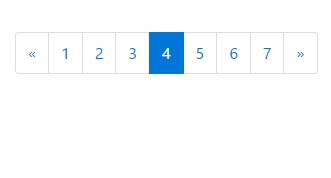
<nav>
<ul class="pagination">
<li class="page-item">
<a href="#" class="page-link" aria-label="Previous">
<span aria-hidden="true">«</span>
</a>
</li>
<li class="page-item"><a href="#" class="page-link">1</a></li>
<li class="page-item"><a href="#" class="page-link">2</a></li>
<li class="page-item"><a href="#" class="page-link">3</a></li>
<li class="page-item active"><a href="#" class="page-link">4</a></li>
<li class="page-item"><a href="#" class="page-link">5</a></li>
<li class="page-item"><a href="#" class="page-link">6</a></li>
<li class="page-item"><a href="#" class="page-link">7</a></li>
<li class="page-item">
<a href="#" class="page-link" aria-label="Next">
<span aria-hidden="true">»</span>
</a>
</li>
</ul>
</nav>Disabled Status
A disabled hyperlink can not be clicked:
If a web link for some reason is disabled, add
.disabled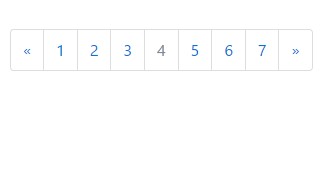
<nav>
<ul class="pagination">
<li class="page-item">
<a href="#" class="page-link" aria-label="Previous">
<span aria-hidden="true">«</span>
</a>
</li>
<li class="page-item"><a href="#" class="page-link">1</a></li>
<li class="page-item"><a href="#" class="page-link">2</a></li>
<li class="page-item"><a href="#" class="page-link">3</a></li>
<li class="page-item disabled"><a href="#" class="page-link">4</a></li>
<li class="page-item"><a href="#" class="page-link">5</a></li>
<li class="page-item"><a href="#" class="page-link">6</a></li>
<li class="page-item"><a href="#" class="page-link">7</a></li>
<li class="page-item">
<a href="#" class="page-link" aria-label="Next">
<span aria-hidden="true">»</span>
</a>
</li>
</ul>
</nav>Pagination Sizing
Paging blocks can also be sized to a larger or much smaller proportions.
Add
.pagination-lg.pagination-sm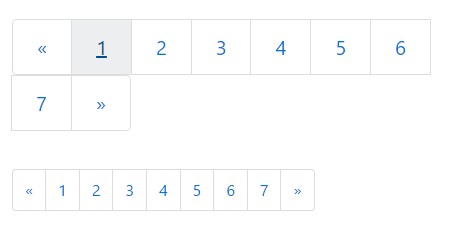
<nav>
<ul class="pagination pagination-lg">
<li class="page-item">
<a href="#" class="page-link" aria-label="Previous">
<span aria-hidden="true">«</span>
</a>
</li>
<li class="page-item"><a href="#" class="page-link">1</a></li>
<li class="page-item"><a href="#" class="page-link">2</a></li>
<li class="page-item"><a href="#" class="page-link">3</a></li>
<li class="page-item"><a href="#" class="page-link">4</a></li>
<li class="page-item"><a href="#" class="page-link">5</a></li>
<li class="page-item"><a href="#" class="page-link">6</a></li>
<li class="page-item"><a href="#" class="page-link">7</a></li>
<li class="page-item">
<a href="#" class="page-link" aria-label="Next">
<span aria-hidden="true">»</span>
</a>
</li>
</ul>
</nav>
<nav>
<ul class="pagination">
<li class="page-item">
<a href="#" class="page-link" aria-label="Previous">
<span aria-hidden="true">«</span>
</a>
</li>
<li class="page-item"><a href="#" class="page-link">1</a></li>
<li class="page-item"><a href="#" class="page-link">2</a></li>
<li class="page-item"><a href="#" class="page-link">3</a></li>
<li class="page-item"><a href="#" class="page-link">4</a></li>
<li class="page-item"><a href="#" class="page-link">5</a></li>
<li class="page-item"><a href="#" class="page-link">6</a></li>
<li class="page-item"><a href="#" class="page-link">7</a></li>
<li class="page-item">
<a href="#" class="page-link" aria-label="Next">
<span aria-hidden="true">»</span>
</a>
</li>
</ul>
</nav>
<nav>
<ul class="pagination pagination-sm">
<li class="page-item">
<a href="#" class="page-link" aria-label="Previous">
<span aria-hidden="true">«</span>
</a>
</li>
<li class="page-item"><a href="#" class="page-link">1</a></li>
<li class="page-item"><a href="#" class="page-link">2</a></li>
<li class="page-item"><a href="#" class="page-link">3</a></li>
<li class="page-item"><a href="#" class="page-link">4</a></li>
<li class="page-item"><a href="#" class="page-link">5</a></li>
<li class="page-item"><a href="#" class="page-link">6</a></li>
<li class="page-item"><a href="#" class="page-link">7</a></li>
<li class="page-item">
<a href="#" class="page-link" aria-label="Next">
<span aria-hidden="true">»</span>
</a>
</li>
</ul>
</nav>Improve the position of pagination parts with flexbox utilities.

<nav aria-label="Page navigation example">
<ul class="pagination justify-content-center">
<li class="page-item disabled">
<a class="page-link" href="#" tabindex="-1">Previous</a>
</li>
<li class="page-item"><a class="page-link" href="#">1</a></li>
<li class="page-item"><a class="page-link" href="#">2</a></li>
<li class="page-item"><a class="page-link" href="#">3</a></li>
<li class="page-item">
<a class="page-link" href="#">Next</a>
</li>
</ul>
</nav>
<nav aria-label="Page navigation example">
<ul class="pagination justify-content-end">
<li class="page-item disabled">
<a class="page-link" href="#" tabindex="-1">Previous</a>
</li>
<li class="page-item"><a class="page-link" href="#">1</a></li>
<li class="page-item"><a class="page-link" href="#">2</a></li>
<li class="page-item"><a class="page-link" href="#">3</a></li>
<li class="page-item">
<a class="page-link" href="#">Next</a>
</li>
</ul>
</nav>Check a number of on-line video information regarding Bootstrap Pagination
Connected topics:
Bootstrap pagination main records
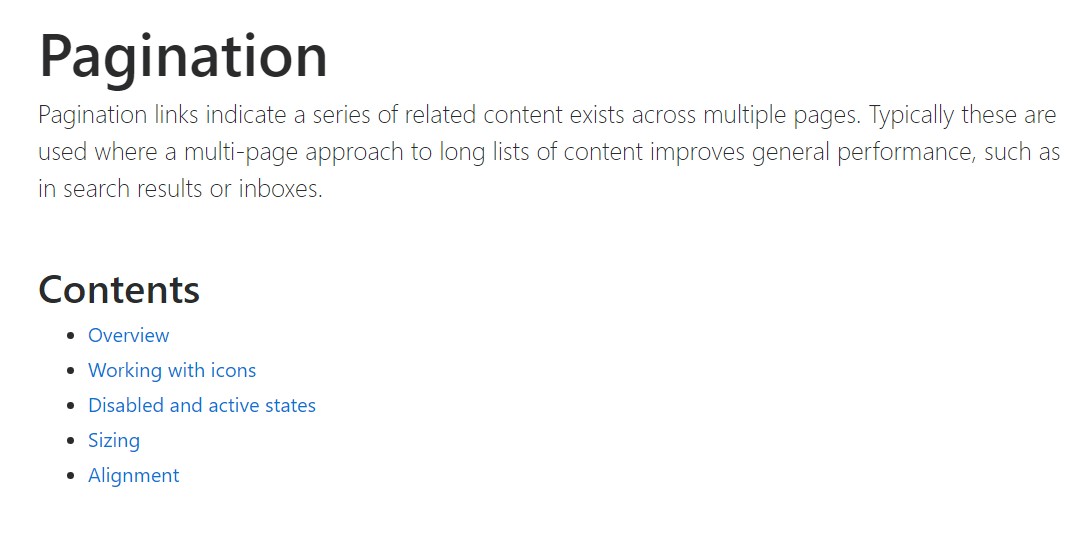
W3schools:Bootstrap pagination tutorial
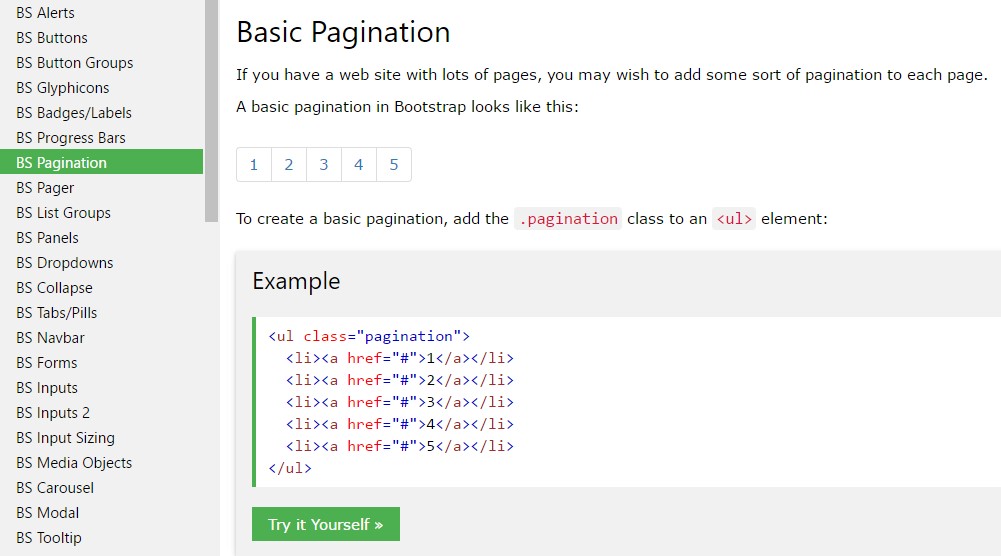
Centering the pagination in Bootstrap
